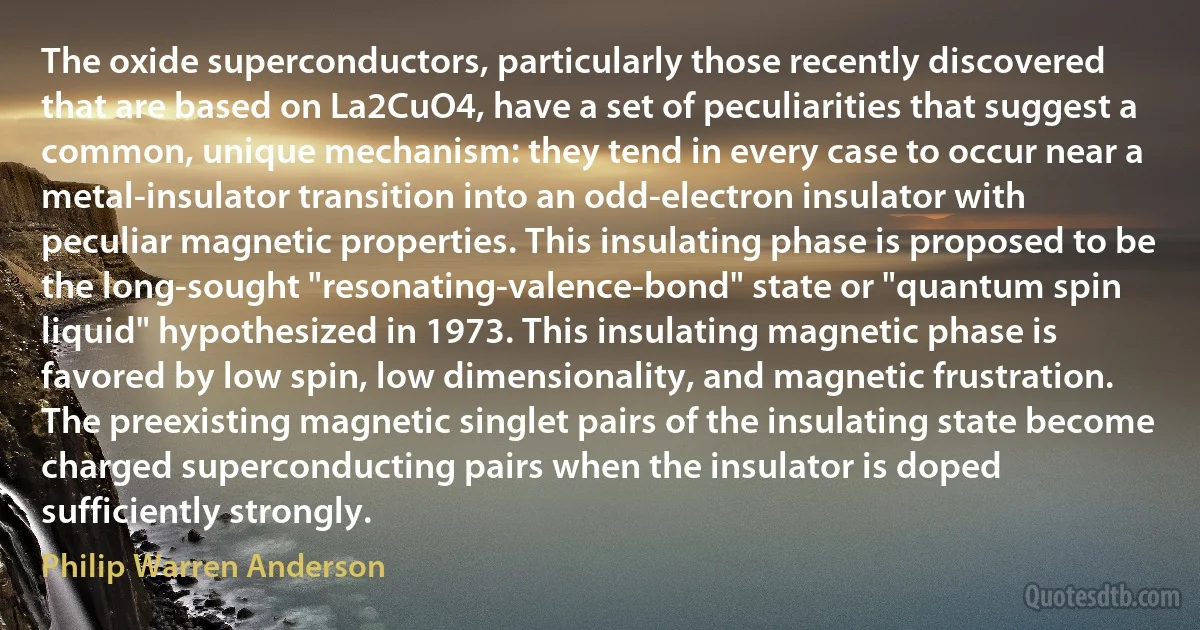
The oxide superconductors, particularly those recently discovered that are based on La2CuO4, have a set of peculiarities that suggest a common, unique mechanism: they tend in every case to occur near a metal-insulator transition into an odd-electron insulator with peculiar magnetic properties. This insulating phase is proposed to be the long-sought "resonating-valence-bond" state or "quantum spin liquid" hypothesized in 1973. This insulating magnetic phase is favored by low spin, low dimensionality, and magnetic frustration. The preexisting magnetic singlet pairs of the insulating state become charged superconducting pairs when the insulator is doped sufficiently strongly.
Philip Warren AndersonRelated topics
case common liquid low magnetic mechanism near quantum set spin state transition uniqueRelated quotes
There is an age old prejudice the world over to effect that women talk too much. But is this really a weakness? Could it not in fact be a strength? Recent scientific research on the human brain has revealed that women are better at verbal skills while men tend towards physical action. Psychological research has shown on the other hand that disinformation engendered by men has a far more damaging effect on its victims than feminine gossip. Surely these discoveries indicate that women have a most valuable contribution to make in situations of conflict, by leading the way to solutions based on dialogue rather than on viciousness or violence?

Aung San Suu Kyi
Now, I should like to say something else to you about the connection with music, primarily that of Bach, i. e. the Fugue or, put more simply, the canon... It has a great deal in common with my own motifs, which I make turn on various axes too. Nowadays I have such a powerful sense of relationship, of affinity, that when I am listening to Bach I frequently get inspired and feel an overwhelming instinct for his insistent rhythm, a cadence seeking something of the infinite. In the Fugue everything is based on a single motif, often consisting of just a few notes. In my work, too, everything revolves around a single closed contour..

M. C. Escher
In 1991, I crossed party lines and supported the use of force against Saddam Hussein, but he was allowed to survive his defeat as the result of a calculation we all had reason to deeply regret for the ensuing decade. And we still do. So this time, if we resort to force, we must absolutely get it right. It must be an action set up carefully and on the basis of the most realistic concepts. Failure cannot be an option, which means that we must be prepared to go the limit. And wishful thinking based on best-case scenarios or excessively literal transfers of recent experience to different conditions would be a recipe for disaster.

Al Gore
If you reject absolutely any single sensation without stopping to discriminate with respect to that which awaits confirmation between matter of opinion and that which is already present, whether in sensation or in feelings or in any immediate perception of the mind, you will throw into confusion even the rest of your sensations by your groundless belief and so you will be rejecting the standard of truth altogether. If in your ideas based upon opinion you hastily affirm as true all that awaits confirmation as well as that which does not, you will not escape error, as you will be maintaining complete ambiguity whenever it is a case of judging between right and wrong opinion. (24)

Epicurus
When loops are present, the network is no longer singly connected and local propagation schemes will invariably run into trouble.. If we ignore the existence of loops and permit the nodes to continue communicating with each other as if the network were singly connected, messages may circulate indefinitely around the loops and process may not converges to a stable equilibrium... Such oscillations do not normally occur in probabilistic networks... which tend to bring all messages to some stable equilibrium as time goes on. However, this asymptotic equilibrium is not coherent, in the sense that it does not represent the posterior probabilities of all nodes of the network.

Judea Pearl
